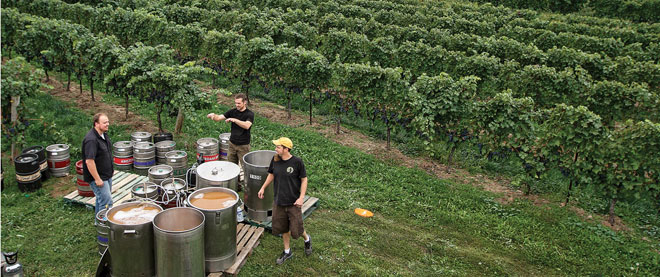A Belgian beer by way of Beamsville
Crazy craft-beer Canucks are going wild with fermentation in an Ontario winery
Photograph by Glenn Lowson
Share

On a grey October afternoon at the Good Earth vineyard in Beamsville, Ont., a crowd gathers around a cluster of steaming stainless-steel vats set up mere feet from the rows of swollen grapes. Iain McOustra, a brewer with Toronto’s Amsterdam Brewing Co. and one of the architects of this madcap plan, periodically stirs a boiled concoction of grains, hops and water that has the hue of milky coffee and smells faintly like shredded wheat. If McOustra is giddy, it’s because he’s exhausted and exhilarated by this, the culmination of three years of research and planning to make a sour beer in the back-breaking style of old-world Belgian breweries.
“This is certainly the craziest brew I’ve ever done,” says the 31-year-old, who’s been brewing beer professionally and in backyards for 13 years. “It’s the most difficult brew to pull off; so much could go wrong.”
Vital to the plan is the winery environment, especially at harvest time, when the air is thick with wild yeast and bacteria that will—it’s hoped—float into the open vessels and ferment the grain mixture, or wort. This is a contemporary take on lambic beer, named after the town of Lembeek, Belgium, where the process was refined in the 1300s.
Where modern brewing methods inoculate the wort with lab-cultivated yeast varieties, traditional lambic beers were fermented spontaneously in shallow tubs called “cool ships” in wood structures where the planks were saturated with native micro-flora. “This was before there were microscopes, before they even knew what yeast was,” says Mike Lackey, a veteran brewer at Toronto’s Great Lakes Brewery, who shares McOustra’s obsessive devotion to beer making.
For Lackey, McOustra and the three other Ontario brewers involved in this opus (Jason Fisher and Jeff Broeders of Indie Alehouse and Sam Corbeil of Sawdust City Brewery), the old-world brewing process required major new-world expertise. “It takes a whole lot of science to dumb it down to the way it was done back then,” McOustra says. “It’s like throwing away everything we learned about brewing.”
It started at Indie Alehouse with a five-hour boil of Ontario milled wheat, stinky aged hops and gallons of water. Broeders and Corbeil babysat the boil overnight. In the morning, Lackey and McOustra transferred the hot wort into 20 kegs, loaded everything into a truck and, in Beamsville, emptied the kegs into the open containers. The next 16 hours, when the wort and yeast were left to mingle in the vineyard, was the fun part. McOustra and Lackey passed around an endless assortment of beers, some from their respective breweries, some wacky creations they cooked up in Lackey’s garage. Winemakers from nearby vineyards wandered over to ask technical questions about acidity and fermentation. The rest of the process was all about transport: moving the wort into 20 clean kegs, back to Toronto and then into four oak wine barrels to ferment for three years. “I’m 100 per cent confident this will work,” says McOustra. “We’ve gone overboard on everything. Typically, there would be a five-hour exposure [to the yeast]; we did 16. Typically, the wort would be put into inert barrels; ours went into unwashed barrels. We were within feet of a vineyard; others might have been within three kilometres.”
If all goes well, the brewers will end up with 800 l of wild sour beer, a wholly unique flavour more tart than sour, crisp and often fruity. They’ll name it “Niambic” (McOustra says you can call a beer lambic only if it was brewed in that region of Belgium). Plans are under way for next year’s wild brew at the same vineyard. “In a few years we can start blending the different vintages, while still maintaining the authentic localness of it.”
The craft beer Twittersphere has been abuzz with the news of a lambic-style brew in Canada. “There are no trade secrets in this world between brewers who are interested in pushing the boundaries of beer,” says McOustra. “We can’t compete with the big guys on pricing, but we can make beers with passion and craft, take chances on stuff and push the industry forward.”